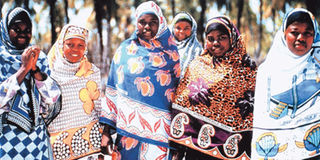Origin of kangas in Tanzania

Swahili women wear kanga on Pate Island, Kenya, 1994 PHOTO I FILE
What you need to know:
- Do you really understand the history of Kanga in Tanzania? Have you tried to take keen interest in understanding this piece of clothing and its uses? Take time to read this:
During colonial times, the British printed kangas bearing Winston Churchill’s slogans to win the support of women.
They had philosophical sayings, in a bid to win the support of Tanganyika’s women who were drumming up support for Mwalimu Nyerere and other heroes who relentlessly fought for this country’s freedom.
Even though they were being given for free by the British, the women still ditched them, and opted for the ones imported from India.
According to Ms Fatma Aloo, the founding member of Tanzania Media Women Association (TAMWA), who also featured in the panel that interviewed the late Bibi Titi Mohammed in 1990, the lady who played a major role in fighting for independence, Mwalimu Nyerere could not put up with the influx of British-made kangas which had by then flooded the market.
It was at this time, Mwalimu called his friend Mahatma Gandhi from South Africa where he was studying law and asked him if he would print kangas for him and intensify the liberation struggle, a request which was duly granted by Gandhi.
Much as it was not easy for the kangas to find their way in, they had to be brought by dhows in Zanzibar, and later sneaked into the Mainland without the Britons’ knowledge.
Ms Aloo says after their arrival, the kangas would later bear inscriptions like Uhuru Sasa (Freedom Now) that irked the Britons and intensified the liberation struggle.
“During the struggle, Kanga was a communication tool and played a crucial role in ousting the Britons from Tanganyika.”
“It was an anti-colonial struggle done underground, and the Britons could not just decipher where they came from.”
Still serving meaningful purposes
Some years later when the country gained its independence, Kangas would later still serve meaningful purposes like campaigning against diseases such as malaria.
They were also used at political rallies, health campaigns, education and on agriculture, according to Ms Mahfoudha Alley Hamid a TAMWA veteran who was a member of the first East African Legislative Assembly and currently serves as Deputy Chair for the Tanzania Human Rights Commission, “Kanga which embodies art, beauty, culture, and customs of coastal women, is almost mythical. Whenever the word kanga is mentioned, we straight away think of it as a normal part of a women’s attire and no more. But there is more to it than meets the eye,” she opines.
To Swahili women of the East African coast, Kanga is an indispensable part of the wardrobe. It comes in pairs and is usually worn by women, although men can occasionally wear a piece while inside the house, tied around the waist.
Once, the late Bi. Kidude, the Taarab legend did not like the way the true essence of clothing was being ignored.
“Nowadays it is common to see women tie kanga around their bottoms and gyrate to the tune of mdundiko dance without being aware of their dignity, pride and value; is that the only use of kanga they have been taught?” once queried Bi. Kidude.
According to Ms Mahfoudha, out of genuine and true respect for the attire, Bi. Kidude would not play her favourite drum and dance to her melodies when she did not have the Kanga tied on her waist.
Bi. Kidude was once quoted as saying “It takes the delicacy and the grace of kanga, for the perfect tying of my drum and nothing can beat it.”
Special meaning
But to some more cultured societies like coastal societies, Kanga colours had special meanings.
For instance, Kangas that had red and black colours symbolized that a woman was in her menstruation circle.
“This made the husband ralize that you were in the red and cannot give him any favours,” says Ms Mahfoudha.
Thus, without words, the wife would inform her husband of her state. White Kangas were adorned during the full moon to symbolize the whiteness of the woman’s heart towards her husband. Other bright coloured kangas were worn to match colourful waist beads of a woman to add to her attraction.
Ms Mahfoudha adds that in Zanzibar, kangas were being used as night attires for both women and men.
For a Zanzibari, an enticing sweet smelling kanga, would act as an aphrodisiac intensifying the intimacy and each other’s need.
Sexy and alluring messages like karibu wangu muhibu (welcome my darling) were enough to entice a man.
As Ms Mahfoudha puts it, the art of putting on the attire among women differs from place to place. On the Mainland coast for instance, women wear the kanga around their waist from one piece, while the second piece is casually thrown over the shoulders. These pieces are worn over the normal dress and the woman is ready to go out regardless of how far the journey is.
During weddings, women from both the bride and groom’s families choose a design as an informal uniform to be worn during celebrations, to solidify the unity of the two families. A young girl who has started menstruation or a woman who has just delivered will be given a red and black coloured kanga, while a bride will be given a special designed kanga of small crosses and rosettes called Kisutu as a symbol of her entering adulthood, according to Ms Mahfoudha.
Ms Mahfoudha adds that Kangas with special messages for the newlyweds were chosen as a good omen. An example is a message reading Nitunze nipendeze waigao wasiweze, meaning ‘cherish me that I nourish’.
There were also messages for straying partners, like Utamaliza mabucha nyama ni ile ile, Swahili for ‘you will exhaust the butcheries, while all the meat tastes the same.’
A less crude one could read “tukae tuishi wazuri hawaishi” implying that the couple should live in harmony as beauties are born every day,” says the TAMWA veteran.
According to her, the use of kanga began from the day a new baby was born whereby it became a tradition to wrap a new born baby with a new pair of kanga.
“This symbolised prosperity, strength, and aesthetic value to the child. It is also a symbol which reflects that the baby is loved. Unfortunately this tradition has died as have a host of others,” she asserts.
New meaning ascribed to wearing kangas
Fast forward, the essence of Kangas has taken new dimensions. For instance, it is common to see women wearing the attire when expressing their feelings.
When two women have picked up a quarrel, they might not end up fighting, a simple message on a kanga would be enough, says Miraji Salum, a kanga vendor at the popular Mnazi Mmoja market in Dar es Salaam.
Miraji, who retails a pair of Kanga from anything between Sh 7,500, says kangas are used to hurl insults and swipes on women who have developed bad blood.
“Don’t play with women they don’t have to square it off when they annoy each other, a message on a kanga is enough to kill it off,” he muses.
Apart from being a platform of hurling dirty messages, women also use them as baby carriers especially when they are attending to their daily domestic chores or when they are taking them to clinic.
In some traditions, a man expecting to marry is expected to buy his mother in-law a number of pairs of kanga, a symbol of respect and gratitude to the family of his would be wife.
“During my introduction I was supposed to buy a sizeable pair of kanga for the mother of my wife as dowry,” recalls Edward Lawei, a journalist who tied the knot in November last year.
During mourning, the attire also takes centre stage whereby women mourners don the dress, something that symbolizes a somber mood.
Kangas also dominate the scene during state visits of foreign dignitaries. For instance in 1990 when Saint John Paul II toured the country, a number of kangas were manufactured and printed in honour of the former leader of the Catholic Church.
So was the case when President Barack Obama of the United States of America visited the country last year where some women like Mama Aisha of Tabata still has in her wardrobe a pair of kanga that has the image of President Obama displaying a message of cooperation between the United States and Tanzania.
“It will serve as a reminder that Obama visited the country as I wear it,” says the mother of two.
Back in the days, companies like Mwatex of Mwanza, Kilitex of Arusha and Sunguratex were household names in the manufacture of the attire.
The industries are no longer existing; companies like KTM and the Tanzania China Friendship Textile Company popularly known as Urafiki have taken over and have continued to manufacture kanga, even though some Tanzanians prefer importing them from India.
Kangas in fashion
In the recent past, some designers and fashionists have taken traditional kanga material in a contemporary design.
Ally Rehmtullah and Sheria Ngowi are household names when it comes to the redefinition of kanga, where in some fashion shows, they have exhibited their prowess of weaving the garment with modernity.
Nevertheless, in the recent times, the respect that the attire has had for ages has taken a nasal dive following the emergence of groups dancing nude using the kanga, popularly known as kanga moko.
The groups, which are still gaining popularity in spite of the government’s efforts of banning them, involve a group of women who wet themselves while wearing the attire and dance seductively to the audience.




